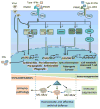Macrophage Polarization in Virus-Host Interactions
- PMID: 26213635
- PMCID: PMC4512304
- DOI: 10.4172/2155-9899.1000311
Macrophage Polarization in Virus-Host Interactions
Abstract
Macrophage involvement in viral infections and antiviral states is common. However, this involvement has not been well-studied in the paradigm of macrophage polarization, which typically has been categorized by the dichotomy of classical (M1) and alternative (M2) statuses. Recent studies have revealed the complexity of macrophage polarization in response to various cellular mediators and exogenous stimuli by adopting a multipolar view to revisit the differential process of macrophages, especially those re-polarized during viral infections. Here, through examination of viral infections targeting macrophages/monocytic cells, we focus on the direct involvement of macrophage polarization during viral infections. Type I and type III interferons (IFNs) are critical in regulation of viral pathogenesis and host antiviral infection; thus, we propose to incorporate IFN-mediated antiviral states into the framework of macrophage polarization. This view is supported by the multifunctional properties of type I IFNs, which potentially elicit and regulate both M1- and M2-polarization in addition to inducing the antiviral state, and by the discoveries of viral mechanisms to adapt and modulate macrophage polarization. Indeed, several recent studies have demonstrated effective prevention of viral diseases through manipulation of macrophage immune statuses.
Keywords: Antiviral state; Interferon; Macrophage polarization; Viral infection; Virus-host interaction.
Figures


Similar articles
-
An M2 Rather than a TH2 Response Contributes to Better Protection against Latency Reactivation following Ocular Infection of Naive Mice with a Recombinant Herpes Simplex Virus 1 Expressing Murine Interleukin-4.J Virol. 2018 Apr 27;92(10):e00051-18. doi: 10.1128/JVI.00051-18. Print 2018 May 15. J Virol. 2018. PMID: 29491152 Free PMC article.
-
Modulation of Macrophage Polarization by Viruses: Turning Off/On Host Antiviral Responses.Front Microbiol. 2022 Feb 11;13:839585. doi: 10.3389/fmicb.2022.839585. eCollection 2022. Front Microbiol. 2022. PMID: 35222345 Free PMC article. Review.
-
Porcine alveolar macrophage polarization is involved in inhibition of porcine reproductive and respiratory syndrome virus (PRRSV) replication.J Vet Med Sci. 2017 Nov 20;79(11):1906-1915. doi: 10.1292/jvms.17-0258. Epub 2017 Sep 17. J Vet Med Sci. 2017. PMID: 28924090 Free PMC article.
-
The role of macrophage IL-10/innate IFN interplay during virus-induced asthma.Rev Med Virol. 2015 Jan;25(1):33-49. doi: 10.1002/rmv.1817. Epub 2014 Nov 27. Rev Med Virol. 2015. PMID: 25430775 Free PMC article. Review.
-
IL-16 regulates macrophage polarization as a target gene of mir-145-3p.Mol Immunol. 2019 Mar;107:1-9. doi: 10.1016/j.molimm.2018.12.027. Epub 2019 Jan 8. Mol Immunol. 2019. PMID: 30634164
Cited by
-
Immunostimulatory RNA leads to functional reprogramming of myeloid-derived suppressor cells in pancreatic cancer.J Immunother Cancer. 2019 Nov 6;7(1):288. doi: 10.1186/s40425-019-0778-7. J Immunother Cancer. 2019. PMID: 31694706 Free PMC article.
-
Coronavirus induces diabetic macrophage-mediated inflammation via SETDB2.Proc Natl Acad Sci U S A. 2021 Sep 21;118(38):e2101071118. doi: 10.1073/pnas.2101071118. Proc Natl Acad Sci U S A. 2021. PMID: 34479991 Free PMC article.
-
M1/M2 macrophages and their overlaps - myth or reality?Clin Sci (Lond). 2023 Aug 14;137(15):1067-1093. doi: 10.1042/CS20220531. Clin Sci (Lond). 2023. PMID: 37530555 Free PMC article.
-
Innate Immune Responses to Highly Pathogenic Coronaviruses and Other Significant Respiratory Viral Infections.Front Immunol. 2020 Aug 18;11:1979. doi: 10.3389/fimmu.2020.01979. eCollection 2020. Front Immunol. 2020. PMID: 32973803 Free PMC article. Review.
-
Impact of COVID-19 outbreak in an Italian cohort of patients with systemic sclerosis.Ther Adv Musculoskelet Dis. 2020 Sep 24;12:1759720X20953356. doi: 10.1177/1759720X20953356. eCollection 2020. Ther Adv Musculoskelet Dis. 2020. PMID: 33029203 Free PMC article.
References
-
- Martinez FO, Gordon S. The evolution of our understanding of macrophages and translation of findings toward the clinic. Expert Rev Clin Immunol. 2015;11:5–13. - PubMed
-
- Ginhoux F, Jung S. Monocytes and macrophages: developmental pathways and tissue homeostasis. Nat Rev Immunol. 2014;14:392–404. - PubMed
-
- Fejer G, Sharma S, Gyory I. Self-renewing macrophages--a new line of enquiries in mononuclear phagocytes. Immunobiology. 2015;220:169–174. - PubMed
-
- Gentek R, Molawi K, Sieweke MH. Tissue macrophage identity and self-renewal. Immunol Rev. 2014;262:56–73. - PubMed
Grants and funding
LinkOut - more resources
Full Text Sources
Other Literature Sources
